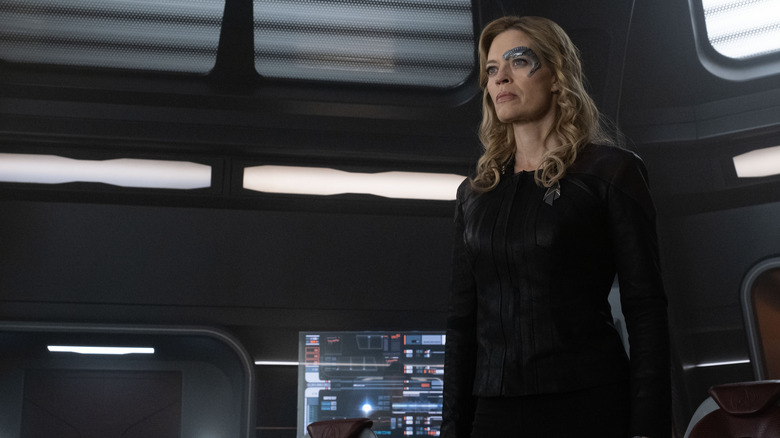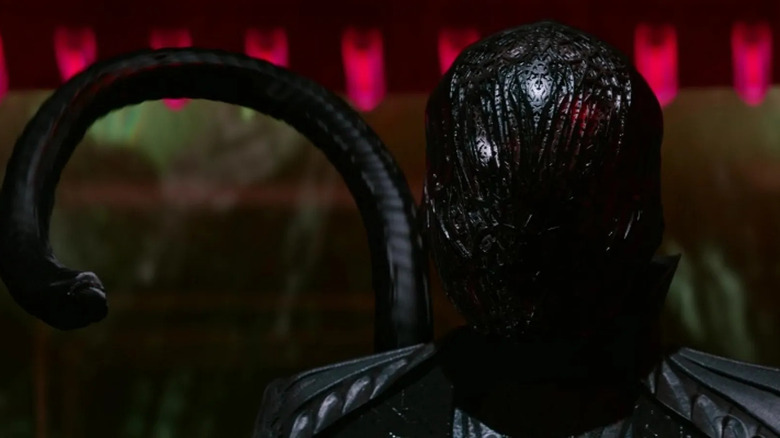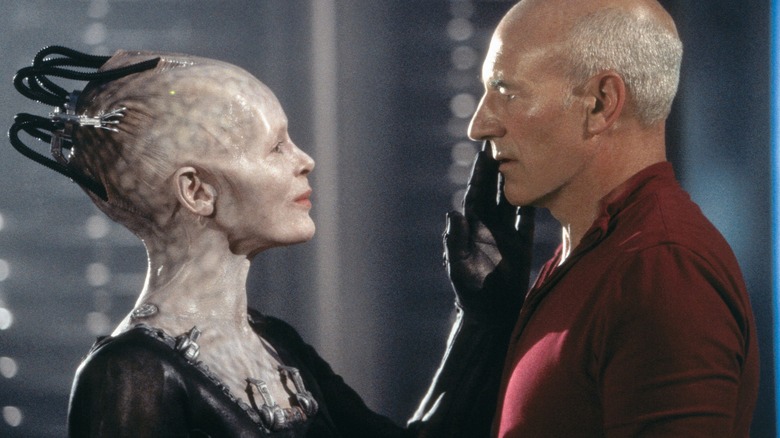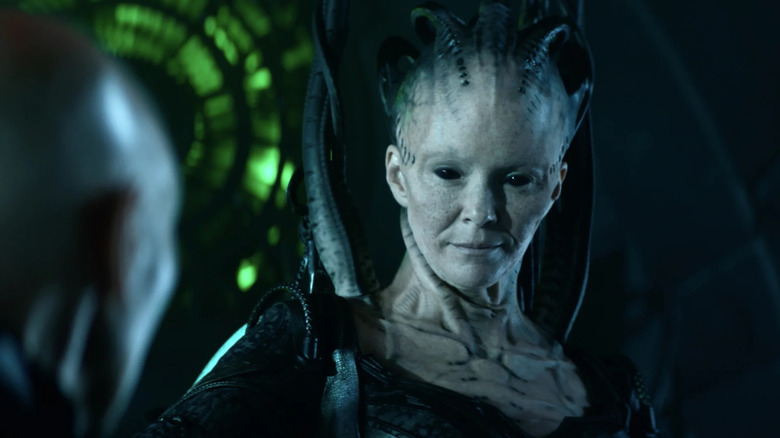Star Trek: Picard Season 3 Proves That A Major Villain Needs To Be Retired For A Long Time
This post contains spoilers for the ninth episode of "Star Trek: Picard," season 3.
In the latest episode of "Star Trek: Picard," called "Võx," one of the season's great mysteries has been revealed. Jack Crusher (Ed Speleers) has been having strange visions for several episodes, seeing an antique red door appearing in his mind's eye. He also seems to have acquired eerie psychic powers as well as the capability to read thoughts and project his consciousness into other people's brains, effectively taking them over. These abilities made Jack of vital importance to Vadic (Amanda Plummer), a vicious Changeling bounty hunter hellbent on kidnapping him. Vadic also, audiences have learned, hijacked Jean-Luc Picard's dead body from a Federation black site (Picard, one might recall, had his own consciousness shunted into a positronic body at the end of "Picard" season 1).
The explanation for both Jack's psychic powers and Vadic's grave robbery is, it seems, rather dumb: when Picard was assimilated by the Borg years before, they left a mysterious genetic "mark" in his brain, a "mark" that contains ... Borg DNA? Not nanotechnology, but a Borg gene. When Picard fathered Jack, he passed the gene to his son, making Jack essentially part Borg. When Deanna Troi (Marina Sirtis) psychically opens up the red door in Jack's visions, she sees a Borg cube on the other side. The Borg Queen (Alice Krige) immediately begins calling.
One can't help but think this will inspire nothing but sighs of weariness from Trekkies in the audience. The Borg again? How many times must we visit the same well?
After so many times dealing with the Borg, they have lost their specialness. They aren't a threat. And in "Picard," they are merely a lazy trope that needs to be retired posthaste.
Early Borg
The Borg plot, of course, is more involved than merely connecting to Jack's brain. After the Changeling cohort got the Borg DNA sequence out of Picard's frontal lobe, they implanted it into the transporters of hundreds of ships, infecting the brains of anyone under 25 who beamed anywhere. When the Queen, with Jack's help, activated their Borg-ified brains, myriad ensigns essentially became Borg drones, tying together thousands of Starfleet vessels to take over the Federation. To what end? I guess because they like to assimilate so much, the Borg are once again handy "bad guys."
And that's an issue. When the Borg first appeared in the "Star Trek: The Next Generation" episode "Q Who" (May 8, 1989), they were terrifying and strange. Clearly inspired by the art of H.R. Giger, they had no goals other than to assimilate the technology — and the people — of the species they encountered. Their ship was a mere cube. They shared a single consciousness and erased individuality from the people they kidnapped. They could repair damage instantaneously and adapted to any weapons or tactics they encountered. Picard (Patrick Stewart) admits that the Borg have the Enterprise handily outmatched. Only literal divine intervention from Q (John De Lancie) can save him. The Borg were set up as so ineffable and overpowered that even the resourcefulness of the Federation was no match for them.
Eventually, the Borg were brought back in the famous two-part episode, "The Best of Both Worlds" (June 18 and September 24, 1990). That was the episode in which Picard was assimilated. By the end of the two parts, the Borg, led by Picard, had infiltrated Earth's system and murdered thousands. Data (Brent Spiner), Troi (Marina Sirtis), and Dr. Crusher (Gates McFadden) managed to hack into the Borg's mainframe and shut down the attack. A non-aggressive finish to a spectacular story.
Descent
And that should have been where we left it. The Borg were finally defeated, but only after they killed many, many people and left Captain Picard traumatized. They could now go back to being distant, mysterious, and largely undefeatable. But the "Star Trek" writers couldn't leave well enough alone and kept going back to the Borg. And, with each visitation, the Borg became gradually less and less threatening. Like Storm Troopers in "Star Wars," they became an army of generic monsters to be gunned down. In "I, Borg" (May 10, 1992) and the two-parter, "Descent" (June 21 and September 20, 1993), it was revealed that Borgs can be taken away from the collective and cured without too many issues.
Most damagingly, the 1996 film, "Star Trek: First Contact," altered the very nature of the Borg. Previously a soulless machine collective, the Borg were transformed into a beehive. They now had specific, malevolent plans and were led by a villainous Queen (Alice Krige). The Queen had a personality and talked about how the Borg were all about achieving perfection. With a human voice and a recognizable motivation, the Borg were no longer threatening. They could now be reasoned with, distracted, and bested. With a human voice, they could now engage in negotiations. This was the opposite of what they were previously.
One can see a "Star Trek" writer straining to add some new wrinkles to the Borg's mythology in order to keep their story going, but in adding said wrinkles, they robbed the Borg of their dramatic power.
Post-Voyager
"Star Trek: Voyager" essentially sealed the coffin shut on the Borg, having them appear as regular villains throughout the series. Captain Janeway (Kate Mulgrew) was able to strike a deal with the Borg, arranging an exchange of technology. One of the show's main characters, Seven of Nine (Jeri Ryan), was a rescued Borg. Later in the series, several characters deliberately allowed themselves to be assimilated, knowing it was temporary. After that, several Borg children were rehabilitated. It seems that assimilation isn't as bad as all that. You just need the metallic implants removed.
One of the plot points of the first season of "Picard" was that the Romulans had been operating a mass de-assimilation project, having commandeered a Borg cube of their own. The Borg are now a mere public works project. The second season of "Picard" saw Dr. Jurati (Alison Pill) threatened by a new Borg Queen (Annie Werching), who took over her mind. Dr. Jurati, however, eventually announces that the Borg had turned over a new leaf, now believing in diplomacy and togetherness.
The shock of seeing a Borg ship no longer bears any punch.
When Jack Crusher opened his mind-door and a Borg ship was lurking behind it, one's reaction might be one of "Yeah? So?" Trekkies have now spent so much time with the Borg and their monstrousness has been downplayed so often, that Jack's Borg-ness hardly seems like a threat, nor is it shocking. Also, if the Borg now have motivations, one might begin to ask why the Borg felt like they needed to assimilate Earth. If it was mere revenge for Earth's prior victories, then, golly that's the least interesting motivation imaginable.
It's time to hang up the Borg. It should have happened long ago. Their appearance on "Picard" ultimately hurt the series.



